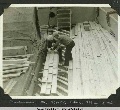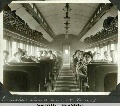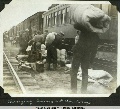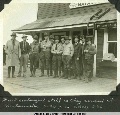|
In 1935, Americans were struggling through the worst economic depression in history. Rural areas of the northern states were among the worst of sufferers. As part of a Federal Emergency Relief Administration project, President Franklin D. Roosevelt commissioned families from the states of Minnesota, Wisconsin, and Michigan to migrate north to live in an experimental farming community in the Territory of Alaska. These three northern states were chosen because of the 48 states in the Union, their climate was most similar to that of Alaska. The administration believed representatives from these states were well suited to survive the harsh elements of subarctic winters. Also, the would-be colonists were chosen from areas where the percentage of bankrupt citizens was the greatest in the nation. Ultimately, 203 select families received passage to Alaska to claim and work 40 acres of farmland near the foot of Pioneer Peak in the Matanuska Valley, north of Anchorage.
Evangeline Atwood migrated to Anchorage with her husband at nearly the same time as the colonists. "The qualifications were clear," Atwood in her book We Shall Be Remembered, "the hardy, pioneer type -- not too many children -- not too young and not too old -- should know a little something about farming, but other trades will help too -- can't have too many unpaid bills -- opportunity would be offered to the worthy."
Roosevelt's New Deal was meant to boost the economy through relocation of American citizens and through public works projects. Most of the citizens chosen for the Matanuska project were of blue-collar and hard labor backgrounds, ready to work the soil to survive.
The administration was careful to select families they believed were most likely primed for success. However, statistics and research can only tell so much. Unknown to the government, several enrollees were later found to carry tuberculosis, and one had spent a significant amount of time in a sanitarium in Oregon.
The settlers made the long journey to the Matanuska Valley with relative success. The first contingent, from Minnesota, boarded a train in April 1935. San Francisco and the U.S.M.S. North Star welcomed the colonists at the first post of their journey.
Of these passengers, Atwood wrote, "In addition to the colonists, four hundred transient single men, together with nurses, doctors, reporters, photographers, and forty relief administrators crowded the ship's passenger list beyond the thousand mark."
The North Star followed the Inside Passage, stopping in Ketchikan and Juneau before arriving in Seward on May 4. The colonists, weakened by seasickness and a threat of measles, rallied in Seward as the "transients" moved onward to the Matanuska Valley. Lengthy Alaskan spring sunlight allowed the colony staff and contingent transients to work for long hours. In less than a week, on May 10, 1935, Palmer welcomed the first of the Valley colonists to their home. A newly constructed base camp (complete with a mess hall and hospital tent) transformed the travel-weary migrants into a community of settlers.
Three days later, families from Michigan and Wisconsin journeyed by rail to Seattle to meet the U.S. Army Transport St. Mihiel. Illness had forced six families of mothers and children to stay in Washington and come to Seward later in the month; however, the rest of the colonists from Michigan and Wisconsin docked in Seward just 10 days before they were to draw their plots of land.
Evangeline Atwood recounts the second contingent's journey as one that was pressed for time: "When the St. Mihiel docked at Seward on May 22, the women and children were shocked to learn that they were to remain aboard ship while their menfolk continued on to Palmer." The men desperately needed to make the drawing, scheduled for the next day in Palmer. They left their families on the ship to secure their investment.
On May 23, 1935, each family was to receive 40 acres for cultivation. The move had not been easy, and the settlers quarreled over who was given the best land, and which occupations were most apt for each colonist. They complained of overpriced goods and the slow delivery of essential tools and materials.
"There were rumors that some of the disgruntled were planning to take the train to Seward, where the St. Mihiel was still in port, to return to their stateside homes," wrote Atwood. "But when the transport was ready to leave, not a renegade colonist was in sight."
Eventually, the settlers' pride that often spurred them to argue among themselves was the same force that drove them to stay. They could not return after risking so much. Their previous communities were still poverty-stricken. In short, there was still nothing to which they could return.
In her 1985 book marking the 50th anniversary of the Matanuska Colony, author Brigitte Lively wrote, "Of course, these victims of the depression really had nothing to lose by coming, and it is said that many, for that reason, came up 'just for the ride.'"
Despite the quarreling, the disease, and the difficulty that came from farming in new land and elements, most of the settlers survived. They were able to meet basic needs and provide for their families. Admittedly, many left for already established townships. But there is no denying the effect this project had on the region. The townsite of Palmer was laid out and the small city of Anchorage grew in population, at least in part from the notoriety of the Matanuska colonists.
The new Alaskan settlers were never claimed by the majority of America as a success. Most historians would argue that the principal reason for the end of the Great Depression was war, rather than Roosevelt's New Deal. Regardless, the new citizens of the Matanuska Valley proclaimed themselves successful.
"The hopes and dreams of those that joined the colony were no more than has been pursued since time began," wrote author Lively in 1985. "Shelter and security for the family. They wished for these essentials, because where they came from these basic human needs were denied. Only when there is not threat to these needs does man hope and strive for other goals. The colonists that stayed in the Valley reached their goals. Most consider that reaching these goals were their greatest accomplishments."
More than 80 years have passed since the first colonists arrived, and the Matanuska Valley remains a productive agricultural region specializing in dairy products, potatoes, rhubarb, lettuce, and giant cabbages. (Palmer is the site of the Guinness World Record for "Biggest Broccoli," grown in 1993 by residents John and Mary Evans. The vegetable weighed a whopping 35 pounds.) The annual Alaska State Fair is held in Palmer and many historic buildings dot the fairgrounds. The displays of giant vegetables and the cabbage weigh-off always draw a big crowd. Today the Matanuska-Susitna Borough (Alaska's equivalent of a county government) encompasses more than 24,000 square miles, larger than many eastern seaboard states. And descendants of the original colonists can be found in the Palmer and Wasilla phone book.
The Palmer Chamber of Commerce distributes walking tour maps of their town, giving walkers the opportunity to see the five various house styles available to the colonists, who endured life in a tent city as they cleared land and began building.
The Colony House Museum, at 316 E. Elmwood, Palmer, is housed in one of the original homes and displays typical furnishings of that time. Another museum can be found in the lower level of Palmer's log cabin visitor center with many examples of Colony memorabilia.
Be sure to check for availability online through your local library catalog at http://sled.alaska.edu/library.html. For the statewide Alaska Library Network catalog, go to http://sled.alaska.edu/library.html and click on ALNCat.
|
 |
 |
| Unloading the North Star, May 5th [1935] |
|
|
|
 |
| Enrollees leaving Seward for Palmer |
|
|
|
 |
| Enrollees aboard train at Seward |
|
|
|
 |
| Changing trains at Anchorage |
|
|
|
 |
| First contingent staff as they arrived at Matanuska, 4:30 p.m., May 6th [1935] |
|
|
|
| Click here for all 17 photos in this gallery. |
|




